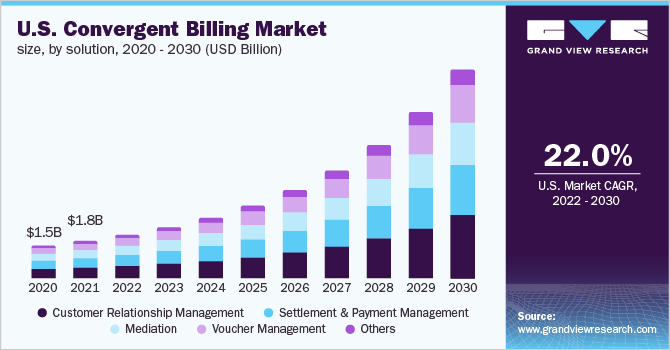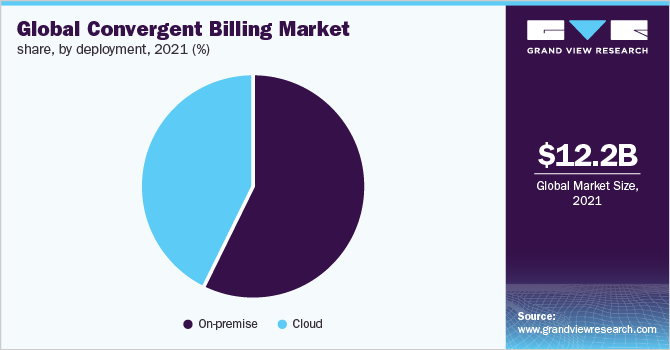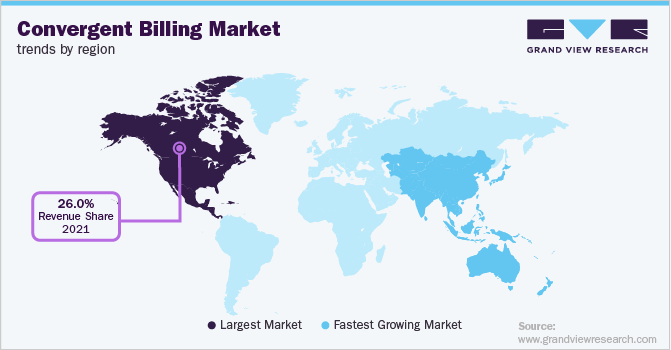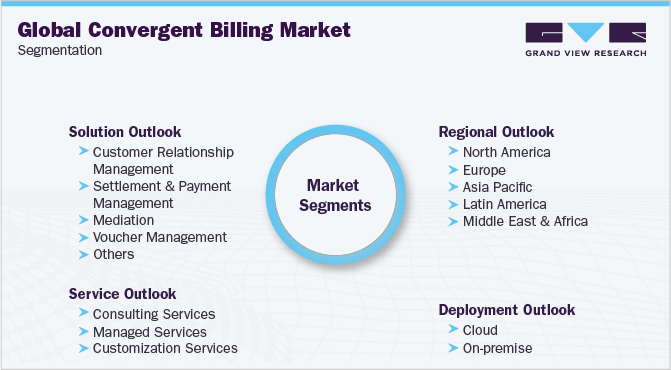- Home
- »
- Next Generation Technologies
- »
-
Convergent Billing Market Size & Share Report, 2022-2030GVR Report cover
![Convergent Billing Market Size, Share & Trends Report]()
Convergent Billing Market Size, Share & Trends Analysis Report By Solution (Customer Relationship Management, Settlement & Payment Management, Voucher Management), By Service, By Deployment, By Region, And Segment Forecasts, 2022 - 2030
- Report ID: GVR-4-68039-983-2
- Number of Report Pages: 140
- Format: PDF, Horizon Databook
- Historical Range: 2017 - 2022
- Forecast Period: 2022 - 2030
- Industry: Technology
Report Overview
The global convergent billing market size was valued at USD 12.16 billion in 2021 and is expected to expand at a compound annual growth rate (CAGR) of 21.6% from 2022 to 2030. A convergent billing platform is a revenue management platform used by the telecommunication industry to integrate all service charges into a single customer bill. The consolidated statement gives customers a unified view of all the services they have opted for. The industry growth can be attributed to the reduced cost of billing processes, enhanced customer experience, multiservice packaging and pricing that allows customers to opt for the services at discounted prices, and centralized customer support.

Over the past decade, the use of telecommunication systems has increased considerably. According to the International Telecommunication Union World's Telecommunication Indicators database, the number of cellular subscriptions was 106 per 100 users. The increasing adoption of cellular subscriptions has increased the customer billing database that telecom companies deal with. Convergent billing can offer telecom companies a unified view of their service offerings.
The large number of accounts that telecom firms handle can lead to data complications and human errors. Convergent billing reduces the chances of errors and improves customer service. Convergent billing offers telecom firms a pre-determined model for billing, which improves customer service, and increases customer loyalty and satisfaction. The increased business efficiency offered by convergence billing is driving the growth of the industry.
With the increasing digitization, consumer preference has shifted towards more sophisticated and digitized service offerings. A unified bill gives customers a consolidated view of all the services they have opted for from the company. This unified view offers customers cross-service discounts so that customers who opt for multiple services can get a preferential pricing model. Moreover, the offered discounts can act as a marketing tool to attract more customers to opt for more services. Hence, a single product and service catalog can be provided using convergence billing, giving better marketing time and reducing implementation costs.
The 4G network technology providers use a traditional business model, requiring customers to opt for prepaid or postpaid services beforehand. Additionally, when customers move from one region to another, they are required to change their numbers and billing methods. However, convergent billing can eliminate the stress of changing numbers by unifying all the services on a single cloud platform by leveraging technological advances in the 5G network and Artificial Intelligence (AI) technology. Convergent billing is expected to reinvent billing using AI technologies to meet the needs of 5G in the near future.
With the emergence of smartphones, the telecom industry landscape has changed drastically. Smartphones these days are performing more functions than just transmitting voice and text messages. Therefore, unlimited data plans are more important than ever, pushing operators to offer various services to survive. However, convergent billing can take time. Implementing a convergent billing system can be a slow and tedious process. Transforming an entire billing system can take time. Still, it is seen as an inevitable part of the future of the telecom industry by telecom operators, which is expected to drive the growth of the market over the forecast period.
COVID-19 Impact Analysis
The outbreak of the COVID-19 pandemic is expected to drive the adoption of convergent billing models. The COVID-19 pandemic has shifted the way consumers use smartphones. Smartphones and networks are fulfilling multiple purposes, right from sending voice & text messages, digital media platforms, maps, and travel guides, to work tools. The increasing use of smartphones during the pandemic has increased the need for unlimited data plans. Therefore, the demand for various services has increased, driving telecom operators' adoption of convergent billing models to satisfy their customers' needs.
Solution Insights
The Customer Relationship Management (CRM) segment dominated the convergent billing market in 2021 with a revenue share of more than 28.0%. CRM covers the organization's guiding principles while interacting with its customers. It encompasses direct customer interaction, including sales & service-related processes, forecasting, and consumer behavior analysis. CRM solutions can offer customer support, segment-based product offerings, and advanced discount mechanisms. Additionally, there is no limit on the number of defined services, which makes CRM an essential tool in the convergent billing market, thereby driving the segment growth.
The mediation segment is anticipated to register significant growth over the forecast period. Convergent mediation allows telecom service providers to combine prepaid and postpaid services. The mediation solution segment combines traditional and non-traditional mobile network channels, which carry conventional and nonconventional data, such as video, and phone services. The growth is anticipated to be driven by the mediation solution's capacity to integrate legacy systems and assist service providers in enhancing multi-service revenue streams.
Service Insights
The managed services segment accounted for the largest revenue share of more than 48.0%. Managed services ensure that the software/application runs smoothly on the customer's system. Managed systems allow businesses to focus on their core business and services by taking responsibility for the software/application's IT-related tasks. Managed services also include various other value-added services to help companies to achieve optimum use of the convergent billing software. The increased performance and reliability offered by managed services are expected to drive the segment’s growth.
The consulting services segment is anticipated to register significant growth over the forecast period. The convergent billing consulting services focus on operating and supporting convergent billing systems, data warehouses, and customer care. These services usually provide consulting, implementation, and support services of convergent billing solutions to a telecom service provider. Using these consulting services, telecom companies can effectively develop efficient business processes in areas including customer care, marketing, sales, and finance which contribute to the growth of the segment.
Deployment Insights
The on-premise segment accounted for the largest revenue share of more than 57.0% in 2021. On-premise deployment enables installing all the hardware and software required to operate and maintain convergent billing software on the customer’s system. On-premise solutions ensure extra security since they are deployed on the customer’s infrastructure and do not involve any third party. The benefits of on-premise deployment can be realized only when investment in professional services increases since on-premise deployment can be expensive at times.

The cloud deployment segment is expected to register the fastest growth over the forecast period. Customers worldwide prefer cloud convergent billing services because of their scalability and convenience. It offers a secure intranet for employees to communicate and collaborate, which reduces processing time. Cloud-based services also reduce deployment time and overhead IT costs, which is expected to drive the adoption of the cloud deployment segment over the forecast period.
Regional Insights
North America accounted for the largest revenue share of more than 26.0% in 2021. The region's growth can be attributed to the presence of key players, such as Amdocs and CSG International. Additionally, consumers and businesses in this region have always been early adopters of technology. North American countries, including U.S. and Canada, are investing aggressively in emerging technologies, including cloud platforms, AI, and 5G technology. The increasing demand to improve customer experience in the region is driving the regional market's growth.

Asia Pacific is predicted to emerge as the fastest-growing region throughout the projection period. The growth can be attributed to the presence of many IT-based companies in the region since they are driving the adoption of advanced technologies supported by research and innovations. Moreover, the large population in countries such as China and India creates a large customer base for telecom providers, propelling the adoption of convergent billing mechanisms and thereby enriching the customer experience. Additionally, government initiatives to increase internet penetration are expected to support regional growth.
Key Companies & Market Share Insights
The convergent billing industry can be described as a highly fragmented market. Prominent players are pursuing various strategies, such as product developments, mergers & acquisitions, collaborations, partnerships, and geographical expansions to cement their foothold. Players are focusing on offering both on-premise and cloud-based solutions to telecom businesses of all sizes. Additionally, key players are investing aggressively in advanced technologies to offer their customers better solutions.
Vendors are focusing on incorporating the latest technology trends. For instance, in September 2022, a prominent provider of Business Support System (BSS) and digitalization solutions, Nexign, announced the launch of a new revenue management solution that provides a single cloud convergent platform to manage the entire revenue generation process. The solution provides operational flexibility and supports the monetization of 5G services. The new launch of advanced solutions leveraging modern technology bodes well for the market’s growth. Some prominent players in the global convergent billing market include:
-
Nokia Corporation
-
Sterlite Technologies Limited
-
Amdocs
-
Optiva Inc.
-
SAP SE
-
Huawei Technologies Co., Ltd.
-
CSG International
-
Mind CTI
-
Comarch SA
-
IDI Billing
Conversion Billing Market Report Scope
Report Attribute
Details
Market size value in 2022
USD 14.11 billion
Revenue forecast in 2030
USD 67.34 billion
Growth rate
CAGR of 21.6% from 2022 to 2030
Base year of estimation
2021
Historical data
2017 - 2022
Forecast period
2022 - 2030
Quantitative units
Revenue in USD million and CAGR from 2022 to 2030
Report coverage
Revenue forecast, company market share, competitive landscape, growth factors, and trends
Segments covered
Solution, service, deployment, region
Regional scope
North America; Europe; Asia Pacific; Latin America; MEA
Country scope
U.S.; Canada; U.K.; Germany; France; Italy; Spain; China; Japan; India; Australia; South Korea; Brazil; Mexico; Saudi Arabia; South Africa; UAE
Key companies profiled
Nokia Corporation; Sterlite Technologies Limited; Amdocs; Optiva Inc.; SAP SE; Huawei Technologies Co., Ltd.; CSG International; Mind CTI; Comarch SA; IDI Billing
Customization scope
Free report customization (equivalent to up to 8 analysts working days) with purchase. Addition or alteration to country, regional & segment scope
Pricing and purchase options
Avail customized purchase options to meet your exact research needs. Explore purchase options
Global Conversion Billing Market Segmentation
The report forecasts revenue growth at global, regional, and country levels and provides an analysis of the latest industry trends in each of the sub-segments from 2017 to 2030. For this study, Grand View Research has segmented the global convergent billing market report based on solution, service, deployment, and region:

-
Solution Outlook (Revenue, USD Million, 2017 - 2030)
-
Customer Relationship Management
-
Settlement and Payment Management
-
Mediation
-
Voucher Management
-
Others
-
-
Service Outlook (Revenue, USD Million, 2017 - 2030)
-
Consulting Services
-
Managed Services
-
Customization Services
-
-
Deployment Outlook (Revenue, USD Million, 2017 - 2030)
-
Cloud
-
On-premise
-
-
Regional Outlook (Revenue, USD Million, 2017 - 2030)
-
North America
-
U.S.
-
Canada
-
-
Europe
-
U.K.
-
Germany
-
France
-
Italy
-
Spain
-
-
Asia Pacific
-
China
-
India
-
Japan
-
Australia
-
South Korea
-
-
Latin America
-
Brazil
-
Mexico
-
-
Middle East & Africa
-
Saudi Arabia
-
South Africa
-
UAE
-
-
Frequently Asked Questions About This Report
b. The global convergent billing market size was estimated at USD 12.16 billion in 2021 and is expected to reach USD 14.11 billion in 2022.
b. The global convergent billing market is expected to grow at a compound annual growth rate of 21.6% from 2022 to 2030 to reach USD 67.34 billion by 2030.
b. North America dominated the convergent billing market with a share of 26.45% in 2021. The region's growth can be attributed to the presence of key market players in the region, such as Amdocs and CSG International.
b. Some key players operating in the convergent billing market include Nokia Corporation; Sterlite Technologies Limited; Amdocs; Optiva Inc.; SAP SE; Huawei Technologies Co., Ltd.; CSG International; Mind CTI; Comarch SA; IDI Billing
b. Key factors that are driving the market growth include enhanced customer experience and Reduced overall operational cost.
Share this report with your colleague or friend.
![gvr icn]()
NEED A CUSTOM REPORT?
We can customize every report - free of charge - including purchasing stand-alone sections or country-level reports, as well as offer affordable discounts for start-ups & universities. Contact us now
![Certified Icon]()
We are GDPR and CCPA compliant! Your transaction & personal information is safe and secure. For more details, please read our privacy policy.
We are committed towards customer satisfaction, and quality service.
"The quality of research they have done for us has been excellent."





